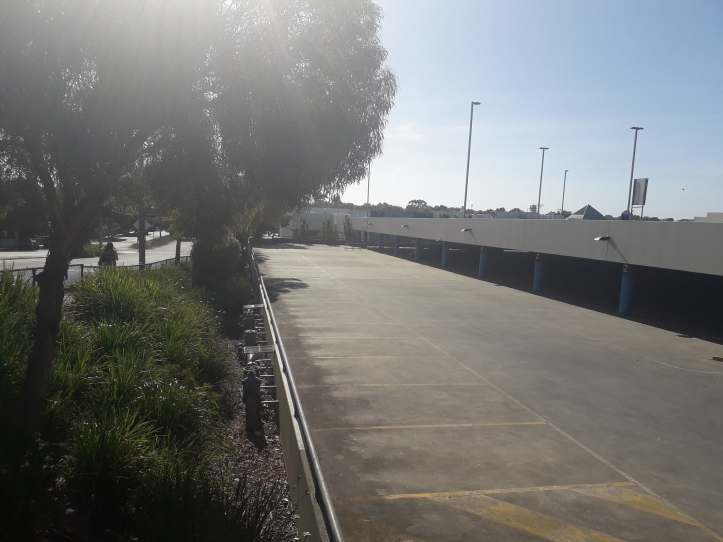Well, we’ve officially made it to Melbourne. Hell of a flight, but we’re here now, and things are looking great. We went down to the local mall, Northland Shopping Centre, and after getting home with a giant (and very cheap) watermelon, I hopped on the computer and did some research. Today we’re going to look at Northland from a city planning perspective. This is something I want to keep fresh – obviously last week I had my trial run with St Mary of the Angels, and you might have noticed that I didn’t even manage to talk about the interior of the building. A thousand words isn’t heaps. I have to pick and choose what I talk about. However, the upside is that the limited scope encourages me to take different approaches for each post. I know I can’t cover everything, so I deploy a diverse set of methods instead. Breadth over depth. Let’s chat about Northland.
So Northland is in Preston, in the north of Melbourne (surprise!). We’re not in Preston, but are instead living in the wider City of Darebin. Now, for me, I’m from Dunedin, and it’s one city, and we have one city council, and that’s how it works – so this whole sub-city thing took me a while to understand. Melbourne, according to Wikipedia, is “an urban agglomeration” of nearly 10,000 square kilometres. From an administrative point of view, it’s not so much one city as thirty-one smaller cities jammed together. Darebin is one of those cities. It has its own mayor, which is fucking weird (means there’s thirty-one mayors in Melbourne), and a population of about 147,000, relatively similar to my hometown of Dunedin (pop. 120k-ish).
Really these sorts of divisions make sense. You don’t want one administration having to deal with five million people all at once. A bunch of different municipalities means more local focus in each individual area, more stewardship. More time to attend to the minor details of everyday life. I was reading the minutes of the most recent council meeting (here, 3 December 2018), and the first question during Question Time was a lady complaining that the council weren’t cleaning leaves off the street fast enough. I read that, and felt oddly at home.
So in these files for the City of Darebin, I came across an old proposal recommending certain developments for Northland and other surrounding areas. The proposal was from 2011 (here again, 7 March 2011, Item 8.2 Appendix B), and having just gone down to Northland for the first time, it made for fascinating reading. I’ll give you a quick bit of context, and then we’ll move on to the building proper. Also, unless I provide an alternate link, assume that I’m quoting facts and figures from that appendix from here on in.

Darebin is growing pretty quick. They expect a 39% increase in population over the next twenty years or so, with an ageing population – projections suggest that by 2031, over-60s will make up 23.7% of Darebin. The city’s biggest employer is education, with 8894 people working in education and teaching, partly thanks to La Trobe University. The second biggest employer is retail, coming in just under education with 8320 workers. Many of those workers will be at Northland, a massive complex holding over 330 stores. That sounds like a massive pull for the area – and in many ways it is. But there are serious problems. I should note here, actually: these reports are from 2010-2011, so they might not be entirely relevant now. Main take-away points are that a) these are things that can be problems for malls, and b) some smart boffins said Northland had these problems a decade ago. I don’t want to suggest that nothing’s changed in that time, except for the areas where we can pretty clearly see that nothing’s changed. We’ll get to those in a minute.
In the initial background report (Appendix A, link listed above), the authors note a whole host of problems with Northland. It’s not as flash or as big as some of the others, and it’s also described as very one dimensional. It’s all just retail. Or at least it was – I noticed today that they had some sort of outpost for the local polytech, as well as accountancy offices. But when all the eggs are in one basket, one type of usage, then it’s easier for the mall as a whole to fall over. In the main report (Appendix B, link above), the authors spell out the necessary development for Northland as an entity. They recommend “transforming the centre into a multifunctional hub where people can live, work and play.” It’s about moving from outdated 60s shopping mall all the way up to civic centre. Towards that end, they recommend bringing in offices, accommodation, evening events of one kind or another. They point out that the ageing population will also require their own particular services, and so catering to that market helps future-proof and diversify the mall. You could also investigate services useful for La Trobe or the wider education sector, which is (after all) the biggest employer in the city. My personal favourite example is still the evening thing. If you’ve just got a mall, everyone shuts up shop at 5PM and goes off to watch TV. The whole area is just deserted. But if you throw in some bars, a movie cinema, maybe some karaoke or something – then you’re making Northland into a hub. It becomes a Destination, a Centre, something beyond the simple 9-5 on-again-off-again shopping experience.

And I’ve not spent long at Northland, but you can clearly see how these suggestions might bear fruit. There’s a giant bungy catapult near the food court – not another clothing stall, just something fun for the kids to go and do. There’s Hoyts upstairs, with its evening viewings of Aquaman. There’s all these opportunities to integrate the mall into the wider social fabric of Darebin, and they powerfully contrast against the isolation and fragility of a one-dimensional retail economy.
Of course, there are ongoing issues in developing that stronger sense of integration. When we arrived at Northland, we came in from the north side. It’s essentially the back entrance, and it’s not great. There’s a carpark on the right, and the back side of the mall on the left, along with a slightly sad pedestrian walkway that seems added almost grudgingly. The report actually explicitly mentions the carpark, suggesting that “Car parking in the centre should not dominate ground level public space in the centre and views of buildings from streets,” and noting that typically, “preferred locations for car parking are in basements and behind building facades, separated from main pedestrian areas.” It’s a pretty basic point: an attractive or artistic storefront is more eye-catching to passers-by than grey concrete carparks. And we see some of those points in action with the back entrance in the photo above. The building on the left is blue, with that interesting little pattern and some advertising, and the carpark on the right has all those trees lining the way down. It all looks okay – although note that it’s a very specific context. Here’s some wider, more general shots of the surrounding area:


It’s a bit more of a bleak environment. It’s not awful per se, but there are definitely better first impressions to be made. For Northland, and any other shopping malls, it’s important to remember that retail is an increasingly fragile industry. Online shopping continues to grow, and multinationals are pushing out the smaller local businesses. If you want your mall to be stable for the future, it can’t just be a place for shopping. Things like art pieces and eye-catching storefronts are important. They wrap buildings more carefully into the wider social fabric of a given community. They provide support and stability by curating an experience that can’t be replicated by some online retailer.

